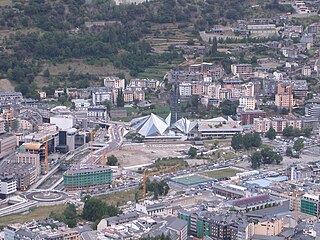
Andorra consists of seven communities known as parishes. Until relatively recently, it had only six parishes; the seventh, Escaldes–Engordany, was created in 1978.

Escaldes–Engordany is one of the seven parishes of Andorra. The Escaldes–Engordany parish was founded in 1978 by being separated from Andorra la Vella. The parish is composed of the areas les Escaldes, Engordany, Els Vilars d'Engordany, Engolasters, and El Fener. As of 2014 it has a population of 13,634, the second largest population after Andorra la Vella. Notable events include the town's annual jazz festival. It borders four parishes: Encamp to the north and northeast, Sant Julià de Lòria in the southwest, Andorra la Vella in the west, and La Massana in the northwest. Escaldes–Engordany also borders Spain in the east, south and southeast.

The General Council is the unicameral parliament of Andorra. It is sometimes referred to as the General Council of the Valleys because it was the historical name and to distinguish it from similarly named bodies in the Val d'Aran and in France.
Listed below are articles about or related to Andorra, arranged alphabetically:

Early parliamentary elections were held in Andorra on 3 April 2011 after the General Council of Andorra was dissolved over problems in passing important laws, including the budget and laws related to a value added tax.

Parliamentary elections were held in Andorra on 9 December 1981, with a second round of voting on 16 December. Local elections were held on the same day. Following the elections, Òscar Ribas Reig became the country's first Prime Minister.

Parliamentary elections were held in Andorra on 12 and 19 December 1985. As political parties were not legalised until 1993, all candidates ran as independents. Following the election, Josep Pintat-Solans remained Prime Minister.

Parliamentary elections were held in Andorra on 10 December 1989, with a second round of voting on 17 December. Following the elections, Òscar Ribas Reig became Prime Minister, elected on 12 January 1990 by a vote of 23−5.

Parliamentary elections were held in Andorra on 5 April 1992, with a second round of voting on 12 April. Following the elections, Òscar Ribas Reig remained Prime Minister.

The Democratic National Initiative was a political party in Andorra.

The 1983 Andorran local elections were held on 12 December. Voters elected the council members of the seven parishes of Andorra. For first time since 1867, local elections were not hold on the same day as parliamentary elections. This was also the first time that the totality of the council seats were up for election.

The 1987 Andorran local elections were held on 13 and 20 December. Voters elected the council members of the seven parishes of Andorra. Following the election, the communal councils elected the mayors and deputy mayors.
The 1991 Andorran local elections were held on 15 and 22 December. Voters elected the council members of the seven parishes of Andorra. Following the election, the communal councils elected the mayors and deputy mayors.
The 2019 Andorran local elections were held on 15 December, to elect all councillors in the seven parishes of Andorra.
Antoni Puigdellívol i Riberaygua was an Andorran businessman and politician.

Parliamentary elections were held in Andorra on 16 December 1955 to renew half of the members of the 24-seat General Council. In constituencies where no candidate won in the first round, a second round was held on 24 December.

Supplementary elections were held in Andorra on 21 July 1978 to elect four members to the General Council. The elections took place following the creation of the parish of Escaldes–Engordany by splitting the parish of Andorra la Vella. The General Council had four members for each parish, and so was increased in size from 24 to 28 seats. Of the four members previously representing the parish of Andorra la Vella, two represented the town of Andorra la Vella and two represented Les Escaldes. As a result of the split of the parish, two additional members were elected from Andorra la Vella and two from Escaldes–Engordany so that each would have four members.

Parliamentary elections were held in Andorra on 14 December 1977 to elect half of the members of the General Council.

Parliamentary elections were held in Andorra on 12 December 1975 to elect half of the members of the General Council. In constituencies where not all seats were filled in the first round, a second round was held on 19 December. They were the first elections in which women could be candidates.

Parliamentary elections were held in Andorra on 12 December 1973 to elect half of the members of the General Council. In constituencies where not all seats were filled in the first round, a second round was held on 19 December and a third on 26 December.




